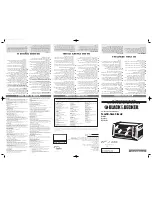
9
If there is other equipment in the room that uses air
(large water heaters, air compressors, other boilers,
exhaust fans, etc.), additional venting capacity is
required.
E. Stack
1. Specifications
Install all stacks in compliance with state and local
codes. Lattner recommends double wall stack per ANSI
Z2231.1, appliance category III for positive vent pressure
systems for boilers operating with a maximum continuous
temperature not exceeding 1000°F.
2. Stack
Size
The entire stack must be the same size as the stack
outlet on the boiler or one size larger. If the boiler stack is
connected to other equipment, the stack size must be
increased.
NOTE:
Any equipment with a forced draft
burner must be vented separately from equipment with
atmospheric burners.
NEVER
tie these stacks together.
3. Connections
Limit connections to one of the following combinations:
Two 90 degree elbows,
One 90 degree elbow and one tee,
One 90 degree and two 45 degree elbows, or
Four 45 degree elbows.
4. Overall
Length
Avoid long runs of stack. A general rule is not to exceed
15 feet for every inch of stack diameter. For example, if
the stack is 6” in diameter then the overall stack should
not exceed 90 feet in length and height combined.
5. Horizontal
Stack
Avoid any horizontal runs of stack. If unavoidable,
horizontal runs should have a minimum incline of 3” per
foot. If a long horizontal run (4 feet or more) cannot be
avoided, a draft inducer may be required to properly vent
combustion gases.
6. Draft
Regulation
A barometric draft regulator should be utilized if unusual
drafts exist or stack is abnormally high (tall).
7. Walls & Ceilings
When passing through combustible walls or ceilings, a
stack thimble is required. The thimble must be double
wall stack, 6” larger in diameter than the vent stack. The
material used to close the opening between the stack
and the stack thimble must be non-combustible.
F. Boiler Shipped with Controls Removed
1. Reassemble
See assembly print in this section, p. 15.
2. Wiring
Re-wiring the controls will be covered in
L: Electrical
Connections. DO NOT
connect the power supply at
this time.
G. Steam
Outlet
1. Pipe
Size
Size steam pipe according to system requirements.
2. Outlet
Size
Refer to product literature sheet for steam outlet size on
a particular boiler model.
3. Steam Stop Valve
Install a steam stop valve in the steam line as close to
the boiler as is practical. This allows boiler to be
isolated from the system during service work and may
be helpful in throttling steam flow. Required by ASME
Code if the boiler is operated over 15 psi. Valve shall
be rising stem or gate type valve.
4. Steam
Piping
Steam line should be pitched downward away from the
boiler and toward a steam trap. If using a steam
solenoid valve, the steam line should slope upward
slightly to the solenoid valve, and after the solenoid
valve, the steam line should slope downward.
5. Code
Standards
Piping must comply with all industry standards (ex.
ANSI B31.1) and all state and local codes.
H. Blowdown Piping (See diagram below)
1. Boiler Bottom Blowdown
DO NOT REDUCE.
Blowdown piping and all fittings
must be the same size as the boiler blowdown
connection (refer to product literature sheets).
Low pressure boilers, operating at 15 psi or less,
require one blowdown or drain valve. The pressure
rating of the valve must be equal to or greater than the
pressure of the boiler safety valve but not lower than 30
psi.
Summary of Contents for Lattner
Page 1: ...Instruction Manual WLF Steam Boilers 2006 to 2007 ...
Page 32: ...Page 32 ...
Page 33: ...Page 33 ...
Page 34: ...Page 34 ...
Page 35: ...Page 35 ...
Page 36: ...Page 36 ...
Page 37: ...Page 37 ...
Page 38: ...Page 38 ...
Page 39: ...Page 39 ...
Page 40: ...Page 40 ...
Page 41: ...Page 41 ...
Page 42: ...Page 42 ...
Page 43: ...Page 43 ...
Page 44: ...Page 44 ...
Page 45: ...Page 45 ...










































